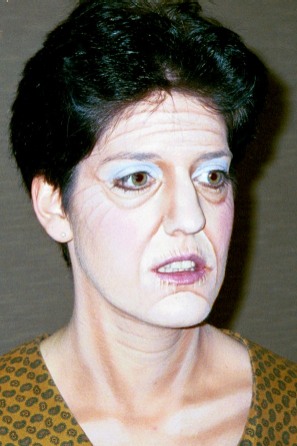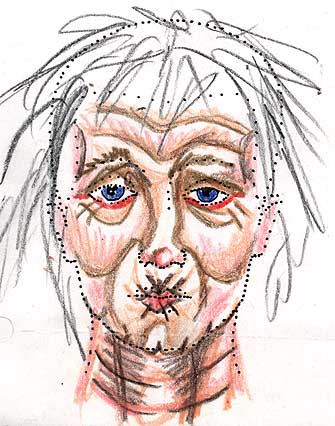Planning your makeup
|
Think about your character. How old is s/he? How much time does s/he
spend outdoors? What kind of grooming habits does your character practice?
In a sense, you have to play what-color-is-your-character. When you choose
a color for your base, consider your own skin color and consider your
character. Remember if you choose a color too different from your own
skin, you'll have to pay scrupulous attention to details like ears, hands,
the back of your neck -- any exposed skin. Although it can be a nuisance,
if your character is the kind of person to have a trendy tan in mid-winter,
and there are references to the time s/he spends in a tanning parlor in
the dialogue of the play, it's worth taking the trouble.
Hands matter -- if your character is 90 years old, you are in your twenties,
and you don't age your hands (or wear gloves), it's likely to make a difference
in your visual credibility. The audience may not be able to identify what's
"off," but they'll sense something. If your character
is rural -- no nail polish. If your character is a big-haired society
babe, long, polished nails (fake or not) add convincing details to the
overall look.
It's all about the credibility of the illusion.
|
Before you begin
|
-
Wash your face and remove any street makeup.
-
Shave (men), if your character is clean-shaven and you have a heavy
beard..
-
Protect your skin, especially if it's sensitive:
-
Use astringent or toner to complete cleaning your face
-
Use moisturizer, especially if you have dry or sensitive skin,
or close your pores with a splash of cold water
-
Change into makeup-safe clothing.
 NEVER
wear your costume while applying makeup. NEVER
wear your costume while applying makeup.
|
|
Managing your hair
|
If you need to add color to your hair, do it now, before applying
makeup:
-
Style it as you will wear it on stage.
-
Apply color with a toothbrush.
-
Use a baby wipe or makeup remover to remove any "drips"
of color.
If you don't need to change your hair color:
- Pull hair back from face with hair band, elastic, or pins if necessary.
|
|
Applying basic makeup
Note: Pale colors and reddish tones bring features forward. Dark
colors make features recede.

|
-
Apply the base color in broad streaks across forehead, down nose,
cheeks, chin, and neck.
-
Blend with sponge until even.
-
Brush sponge over ears, back of neck (if exposed), décolletage
-- any exposed skin should be covered with base. Avoid visible lines
between made-up and bare flesh. No stripey actors!
Run a fingertip across the base -- if it smears, you used too much
makeup, and need to keep blending with a sponge until it passes the
fingertip test.
- Add shadows (contour): sides and tip of nose, under cheekbones, temples,
under jawline, eyesocket, between lower lip and chin. Apply with brush
or Q-tip, then blend slightly with sponge.
Use a cream liner for shadows in some shade of brown, reddish brown,
or purple, depending on your skin tone and the effect you want. DO
NOT use black or gray.
- Add highlights: forehead, above eyebrows, tiredness circles, top
of cheekbone, jawline, eyelids, tip of chin, down center of nose. Apply
with brush or Q-tip, then blend slightly with sponge.
Use a cream liner for shadows in some shade of pale beige or white,
depending on your skin tone and the effect you want. You can blend
a bit of your base color with white for a "custom" highlight
color.
Note: It doesn't matter if you apply shadows or highlights
first -- do whatever is easiest for you.
-
Blend. Tap sponge over the boundaries between highlights and shadows
and soften the line well. We want accents, but not lines (except for
age lines, to be added later).
-
Add cream eyeshadow, cream rouge.
|
|
Powdering to set it
|
-
Powder thoroughly. Use a velour powder puff, and press the
powder into the makeup. It can absorb a fair bit of powder. If you
look as though you've been hit with a sack of flour, you've gotten
it right.
-
Use a soft brush to lightly brush off the excess.
|
|
Adding age (optional)
|
-
Frown, smile, raise your eyebrowss, and scrunch your face to see
where the lines fall.
- Paint in the lines with brownish, reddish brown, or purple cream
liner (depending on your skin tone). Don't forget the neck!
Note: Paint only enough age lines to give the effect of the
age you want to appear; a 50 year old will not have as many lines
as an 80 year old.
-
Add highlights around (especially above) lines.
-
Blend highlights into background and into lines, for more realistic
three-dimensional effect.
- Add a bit of reddish liner under eyes, for tiredness. Don't forget
that bags under eyes look a bit puffy -- which means highlighting!

 (Livingmask.com
site) (Livingmask.com
site)
 Tara McGinnis (costumes.org)
Tara McGinnis (costumes.org)
|
|
Completing the makeup
|
-
Touch up highlight/shadow if necessary.
-
Add powder eyeshadow (optional) , eyeliner, mascara, eyebrow definition
if necessary. Men: use eyeliner only for lower lid, mascara only for
upper lashes.
-
Outline lips (usually with lipliner pencil or brush), then fill
in with lipstick.
|
|
Removing stage makeup
|
-
Use cold cream, baby wipes, or makeup-remover wipes to remove makeup.
-
Wash face, and use astringent, then moisturizer, to finish.
|